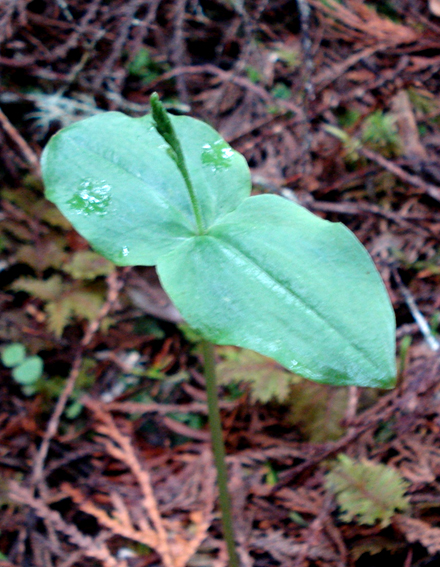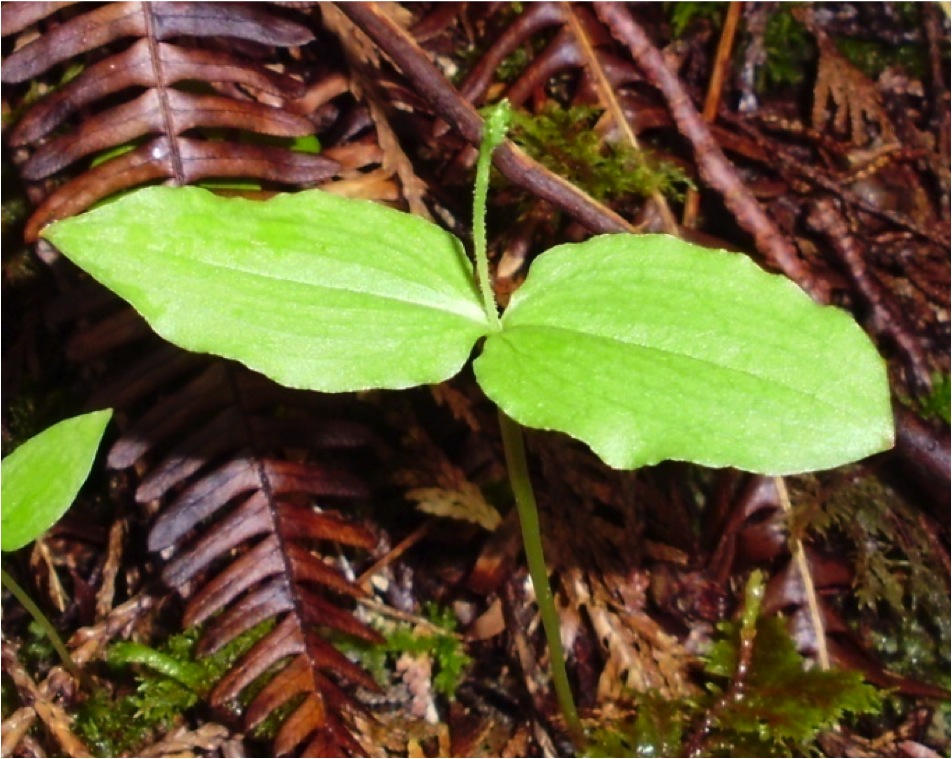Northwestern twayblade • Listera caurina
Identification
Northwestern twayblade is a delicate-looking orchid that grows to 30 cm tall from slender creeping rhizomes. A single pair of opposite leaves clasps the stem mid-way along its length; these leaves grow to 6 cm long and are egg shaped with pointed tips. The stem is very hairy above the leaves. The flowers grow in an elongated cluster at the end of the stem. They vary from pale green to yellowish, and have a rounded lip with a pair of teeth at the flower base.
Click here for further details on flower structure, and for some helpful diagrams.
Habitat & Range
These perennial flower grows in moist to wet locations. It can be found in mossy coniferous forests, meadows, bogs, and along streams from low to subalpine elevations. Its range stretches from Alaska to California, and east to Alberta and some interior areas of the western United States (see range map). It is more common in coastal regions.
Similar Species
Heart-leaved twayblade (Listera cordata) and broad-leaved twayblade (L. convallariodes) are similar species. Heart-leaved twayblade is more often found at middle elevations, and has distinct flower with two long teeth at its base. The lip edge of the broad-leaved twayblade is more notched and has shorter teeth than that of the northwestern twayblade.
Northwestern twayblade is a delicate-looking orchid that grows to 30 cm tall from slender creeping rhizomes. A single pair of opposite leaves clasps the stem mid-way along its length; these leaves grow to 6 cm long and are egg shaped with pointed tips. The stem is very hairy above the leaves. The flowers grow in an elongated cluster at the end of the stem. They vary from pale green to yellowish, and have a rounded lip with a pair of teeth at the flower base.
Click here for further details on flower structure, and for some helpful diagrams.
Habitat & Range
These perennial flower grows in moist to wet locations. It can be found in mossy coniferous forests, meadows, bogs, and along streams from low to subalpine elevations. Its range stretches from Alaska to California, and east to Alberta and some interior areas of the western United States (see range map). It is more common in coastal regions.
Similar Species
Heart-leaved twayblade (Listera cordata) and broad-leaved twayblade (L. convallariodes) are similar species. Heart-leaved twayblade is more often found at middle elevations, and has distinct flower with two long teeth at its base. The lip edge of the broad-leaved twayblade is more notched and has shorter teeth than that of the northwestern twayblade.
References
Listera caurina Piper. In Klinkenberg, Brian. (Ed.). E-Flora BC: Electronic Atlas of the Plants of British Columbia. Lab for Advanced Spatial Analysis, Department of Geography, University of British Columbia, Vancouver. Accessed 09/04/2014.
Pojar, J. and MacKinnon, A. (1994). Plants of Coastal British Columbia. Vancouver, BC: Lone Pine Publishing. P. 121.
Authors and editors of page
Kelly Fretwell and Brian Starzomski (2014).
Listera caurina Piper. In Klinkenberg, Brian. (Ed.). E-Flora BC: Electronic Atlas of the Plants of British Columbia. Lab for Advanced Spatial Analysis, Department of Geography, University of British Columbia, Vancouver. Accessed 09/04/2014.
Pojar, J. and MacKinnon, A. (1994). Plants of Coastal British Columbia. Vancouver, BC: Lone Pine Publishing. P. 121.
Authors and editors of page
Kelly Fretwell and Brian Starzomski (2014).





